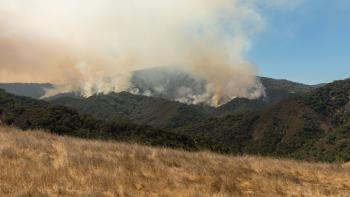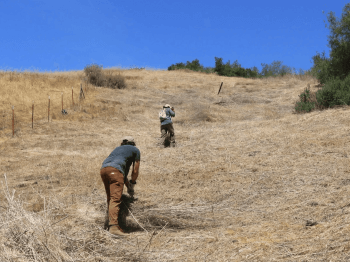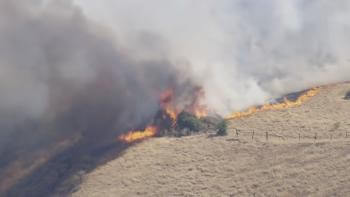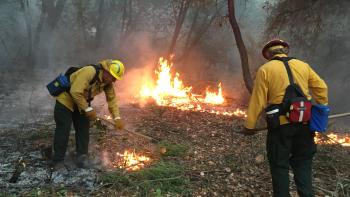
Building Wildfire Resiliency
How Open Space Helps Protect Communities from Wildfire
Using Nature as Defense
The Open Space Authority plays a vital role in wildfire resilience by protecting natural and agricultural lands that act as buffers between wildfires and surrounding neighborhoods.
How Nature Defends Against Fire
- Open space preserves can slow or stop the spread of fire, buying valuable time for evacuations and emergency response.
- These lands reduce the risk of fire reaching homes, acting as a natural shield during wildfire events.
The Role of Agricultural Lands
- Agricultural lands, especially irrigated farmland, can slow wildfire spread by acting as a firebreak.
- Farmlands with minimal vegetation (or fuel) can provide critical time and space for first responders to contain and extinguish wildfire
Stay connected—click here to sign up for our e-newsletter to discover inspiring stories, get the latest updates and enjoy free community events delivered straight to your inbox!
Wildfire FAQ
This section provides answers to frequently asked questions (FAQ) about wildfires.
Managing Dry Brush to Reduce Wildfire Risk
Dry brush and overgrown vegetation are major wildfire hazards. These materials act as fire fuel because they can ignite and burn, which can cause wildfires to grow and spread.

How We Reduce Fire Fuel
- Dry brush is a key contributor to wildfires—regular maintenance is essential to prevent ignition and slow fire spread.
-
The Authority uses a combination of tools to manage vegetation:
* Cattle grazing to naturally reduce grass and brush, while also contributing to the local economy.
* Mapping technology to identify high-risk areas.
* Mechanical and manual removal of overgrown vegetation.
* Heavy equipment and volunteer crews for large-scale brush clearing.
* On occasion, the Authority works with fire personnel to complete prescribed burns which help remove vegetation, improve wildlife habitat and maintain biodiversity.
Volunteer to help reduce fire risk!
The Open Space Authority relies on volunteers to help remove invasive plants and overgrown vegetation from open space. Learn more on our Volunteer page.
Partnering with First Responders for Faster, Safer Fire Response
The Open Space Authority plays a vital support role during wildfire emergencies by working hand-in-hand with first responders and fire agencies.
Collaboration is Key
- We collaborate with CAL FIRE, local fire departments, and emergency personnel to support wildfire containment efforts.
- Open Space Authority field staff are trained and ready to assist during active fire events.
- Our staff provide detailed maps and on-the-ground knowledge of local roads and trails, firebreaks and access points, and terrain features that are not always visible on digital maps.
- Open Space Authority staff also serve on the Santa Clara County FireSafe council that helps protect communities from wildfire.
Removing Fire Hazards from Illegal Dumping
- Field staff regularly monitor for illegally dumped items and construction debris, which can act as dangerous fuel during a wildfire.
- These efforts help keep preserves safe and reduce fire vulnerability
Case Studies

On June 17, 2025, the Ranch Place Fire broke out in an East San José neighborhood, burning 92 acres before it was completely contained.
Despite the fire starting in a residential area, it quickly expanded into the foothills due to the nature of its surroundings: dry brush and vegetation. As a result, the fire was at risk of reaching Sierra Vista Open Space Preserve.
Luckily, the fire was contained before this could happen thanks to fire personnel working closely with the Authority's on-site field staff to access roads and firebreaks that helped them reach and extinguish the fire. Field staff also worked swiftly to alert preserve users of the fire, escorting and directing them to safely.
The Ranch Place Fire was a powerful reminder of the value of protected open space—not just for recreation and habitat, but as a buffer in times of crisis. The preserve’s natural landscape helped slow the fire’s spread, giving first responders critical time and space to act and keep the public safe.

Loma Fire
On September 26, 2016, the Loma Fire began in the Santa Cruz Mountains, lasting 16 days and burning 4,474 acres. Nearly 2,000 acres of Open Space Authority-managed lands were burned during the fire which acted as a buffer between the fire and nearby residences.
The Authority's previously established fuel breaks, or strips of land where vegetation is thinned to reduce fire intensity, helped stop the fire from spreading to homes and causing structural damage in nearby communities.
The formation of an internal Loma Fire Response Team also helped manage the impacts of the fire on the local water supply by controlling erosion near Chesbro and Uvas Reservoirs - both of which supply water to the region.
In addition, the internal response team focused on reducing vegetation and invasive species which decreased future fire risk and supported biodiversity.
Loma Fire Impacts
After the Loma Fire, the Authority commissioned a report to determine the true cost of the fire, which included the loss of many of nature’s benefits (also known as ecosystem services) like erosion control, in addition to the costs of fire suppression and lost structures. The report shows that the damage to nature’s benefits from this fire created an economic loss roughly equal to the cost of fire suppression and burned structures combined
Sign up for our newsletter!
Subscribe to the Open Space Authority's monthly News & Events email to stay up-to-date on our work with wildfire resilience and beyond.